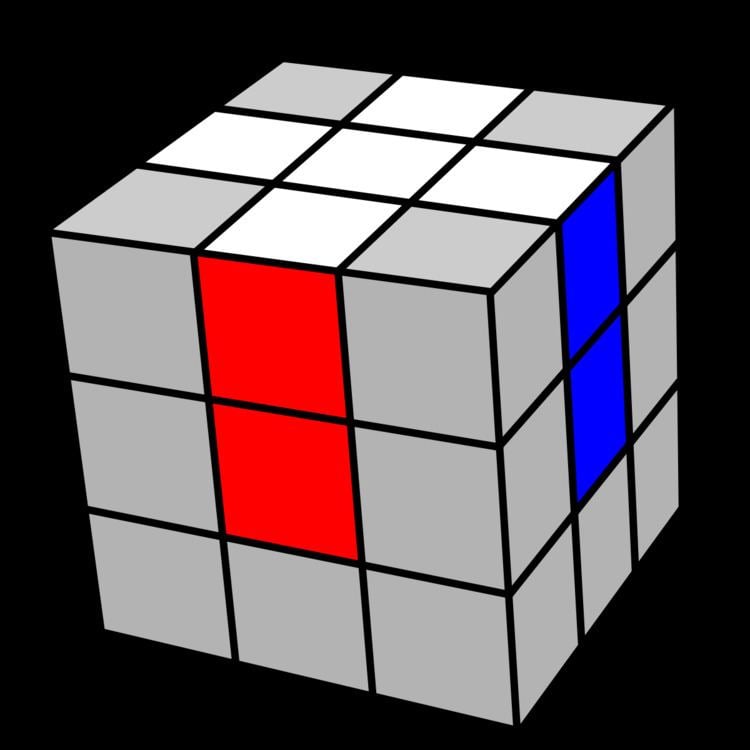The CFOP Method (Cross - F2L - OLL - PLL), sometimes known as the Fridrich method, is one of the most commonly used methods in speedsolving a 3x3x3 Rubik's Cube. This method was first developed in the early 1980s combining innovations by a number of speed cubers. Czech speedcuber Jessica Fridrich is generally given credit for popularizing it by publishing it online in 1997.
The method works on a layer-by-layer system, first solving a cross typically on the bottom, continuing to solve the first two layers (F2L), orienting the last layer (OLL), and finally permuting the last layer (PLL).
Basic layer-by-layer methods were among the first to arise during the early 1980s cube craze. David Singmaster published a layer-based solution in 1980 which proposed the use of a cross.
The major innovation of CFOP over beginner methods is its use of F2L, which solves the first two layers simultaneously. This step was not invented by Jessica Fridrich. According to Singmaster's report on the 1982 world championship, Fridrich was then using a basic layer method, while Dutch competitor Guus Razoux Schultz had a primitive F2L system.
The last layer steps OLL and PLL involve first orienting the last layer pieces, then permuting them into their correct positions. This step was proposed by Hans Dockhorn and Anneke Treep.
Fridrich switched to F2L later in 1987. Her main contribution to the method was developing the OLL and PLL algorithms, which together allowed any last layer position to be solved with two algorithms and was significantly faster than previous last layer systems.
The method consists of 4 steps:
The Cross - This first stage involves solving the four edge pieces in one outer layer of the puzzle, centering around a commonly coloured center piece. Historically, tutorials were made teaching people to solve on the white side first, so this has become common. However, newer speedcubers are commonly becoming 'colour neutral', where the cuber can start solving from the colour with the best start. This step is the most intuitive step of the solve but it is also very fast; experienced speedcubers can solve this step in about 0.5-2 seconds, and in all cases it requires 8 or fewer turns to solve.
Solve the First Two Layers (F2L) - This stage consumes most of the time of the solve as it has the most turns to solve. In most beginner methods, the corners of the cube and edge pieces are solved separately. In F2L, both the corner piece and edge pieces are solved at the same time, reducing the number of turns needed. There are 42 different standard cases for each corner-edge pair, 41 plus the already solved case. However, most cubers solve this step intuitively.
Orientation of Last Layer (OLL) - This stage involves manipulating the top layer so that all the top cubies have the same colour on top, at the expense of incorrect colours on other sides. This stage involves learning a total of 57 algorithms. Because of the large number of algorithms, many speedcubers who are beginning to learn OLL will use the "two-look" OLL subset, which completes the top face's edge stickers and then the corners separately using one in three algorithms for the edges and one in seven for the corners.
Permutation of Last Layer (PLL) - The final stage involves moving the pieces of the top layer while preserving their orientation. There are a total of 21 algorithms for this stage. They are distinguished by letter names, usually based on what they look like with arrows representing what pieces are swapped around (e.g. A permutation, F permutation, T permutation, etc.). "Two-look" PLL solves the corners and edges separately. It uses five algorithms, four for edge permutation and one for corner permutation. Again, the "two-look" method is used for people that don't want to learn a great deal of algorithms.
CFOP is used by most speedcubers, including Rowe Hessler, Mats Valk, and Feliks Zemdegs. CFOP is one of the preferred methods for speedcubing because it relies heavily on algorithms as opposed to more intuitive methods such as Roux or Petrus. By not being intuitive it makes the solver rely only on pattern recognition and muscle memory. The majority of top speed cubers on the WCA ranking list are CFOP solvers.

